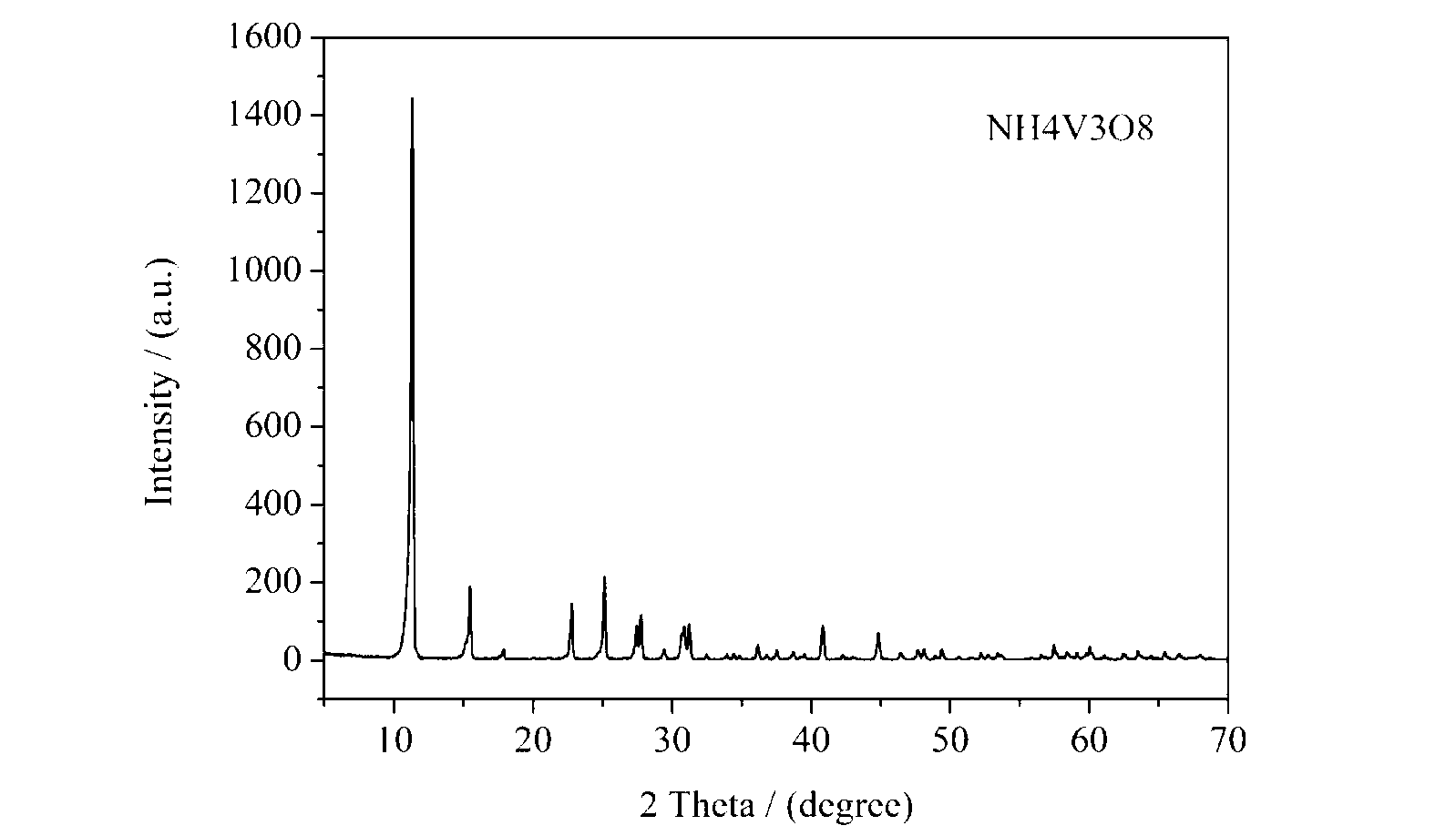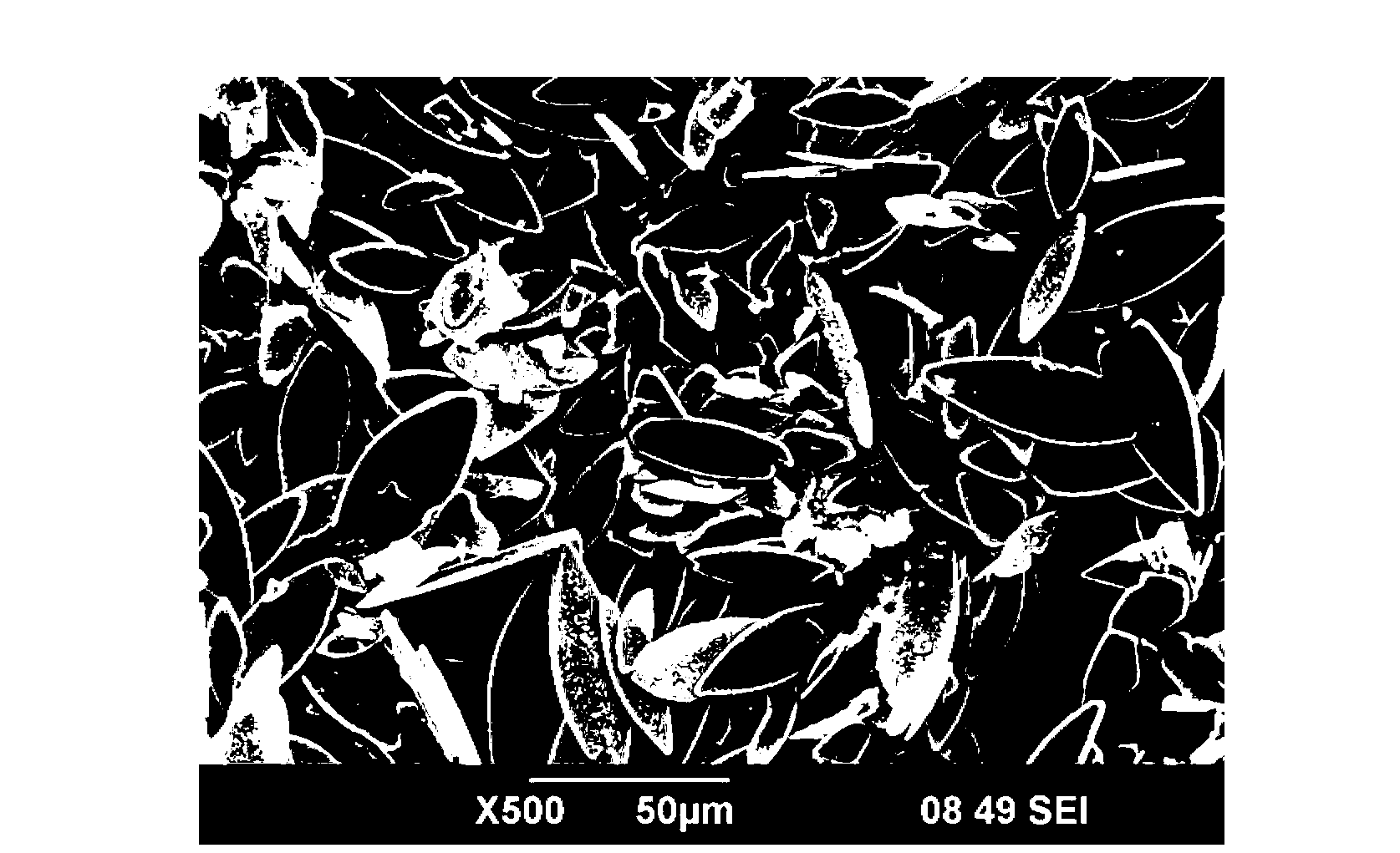Leaf-type NH4V3O8 microcrystalline preparation method
A leaf-shaped, microcrystalline technology, applied in chemical instruments and methods, tungsten compounds, inorganic chemistry, etc., can solve the problems of long process cycle and achieve the effect of simple preparation process, controllable shape and short reaction cycle
- Summary
- Abstract
- Description
- Claims
- Application Information
AI Technical Summary
Problems solved by technology
Method used
Image
Examples
Embodiment 1
[0022] 1) will analyze pure NH 4 VO 3 Dissolved in deionized water with stirring and sonication, formulated as NH 4 + Light yellow transparent NH with a concentration of 0.30mol / L 4 VO 3 Solution, denoted as A solution;
[0023] 2) Dissolve EDTA in deionized water to prepare a solution with an EDTA concentration of 0.10mol / L, which is designated as solution B;
[0024] 3) Mix solution A and solution B according to the volume ratio of 1:0.3, and stir at room temperature for 3 hours to obtain solution C;
[0025]4) Adjust the pH of solution C to 3.0 with hydrochloric acid, and then sonicate solution C for 1 hour at an ultrasonic power of 300W;
[0026] 5) Transfer the ultrasonically treated C solution into a polytetrafluoroethylene-lined reactor, control the volume filling ratio of the reactor to 60%, and then place the reactor with C solution in a microwave hydrothermal instrument, React at 200°C for 30 minutes;
[0027] 6) After the reaction is completed and cooled to ...
Embodiment 2
[0031] 1) will analyze pure NH 4 VO 3 Dissolved in deionized water with stirring and sonication, formulated as NH 4 + Light yellow transparent NH with a concentration of 0.20mol / L 4 VO 3 Solution, denoted as A solution;
[0032] 2) Dissolve EDTA in deionized water to prepare an EDTA solution with an EDTA concentration of 0.05mol / L, solution B;
[0033] 3) Mix solution A and solution B according to the volume ratio of 1:0.5, and stir at room temperature for 4 hours to obtain solution C;
[0034] 4) Adjust the pH of solution C to 2.5 with hydrochloric acid, and then sonicate solution C for 1 hour at 400W ultrasonic power;
[0035] 5) Transfer the ultrasonically treated C solution into a polytetrafluoroethylene-lined reactor, control the volume filling ratio of the reactor to 70%, and then place the reactor with C solution in a microwave hydrothermal instrument, React at 180°C for 40 minutes;
[0036] 6) After the reaction is completed and cooled to room temperature, the ...
Embodiment 3
[0038] 1) will analyze pure NH 4 VO 3 Dissolved in deionized water with stirring and sonication, formulated as NH 4 + Light yellow transparent NH with a concentration of 0.50mol / L 4 VO 3 Solution, denoted as A solution;
[0039] 2) Dissolve EDTA in deionized water to prepare an EDTA solution with an EDTA concentration of 0.20mol / L, which is denoted as B solution;
[0040] 3) Mix solution A and solution B according to the volume ratio of 1:0.6, and stir at room temperature for 5 hours to obtain solution C;
[0041] 4) Adjust the pH of solution C to 2.0 with hydrochloric acid, and then sonicate solution C at 400W ultrasonic power for 1 hour;
[0042] 5) Transfer the ultrasonically treated C solution into a polytetrafluoroethylene-lined reactor, control the volume filling ratio of the reactor to 80%, and then place the reactor with C solution in a microwave hydrothermal instrument, React at 160°C for 60 minutes;
[0043] 6) After the reaction is completed and cooled to ro...
PUM
| Property | Measurement | Unit |
|---|---|---|
| Concentration | aaaaa | aaaaa |
Abstract
Description
Claims
Application Information
 Login to View More
Login to View More - R&D
- Intellectual Property
- Life Sciences
- Materials
- Tech Scout
- Unparalleled Data Quality
- Higher Quality Content
- 60% Fewer Hallucinations
Browse by: Latest US Patents, China's latest patents, Technical Efficacy Thesaurus, Application Domain, Technology Topic, Popular Technical Reports.
© 2025 PatSnap. All rights reserved.Legal|Privacy policy|Modern Slavery Act Transparency Statement|Sitemap|About US| Contact US: help@patsnap.com


